ICP Sales: How to Build an Ideal Customer Profile
Casey O'Connor
An ideal customer profile (also known as a sales ICP) describes the characteristics and attributes of a sales organization’s best-fit buyer.
An effective ICP helps sales reps and marketers easily identify which potential buyers would be most likely to benefit from their offer based on specific details they have in common with their most successful customers.
Today’s B2B buyer expects deep understanding and personalization at every stage of the sales process. A thorough ICP can help sales reps deliver timely, targeted messaging to high-potential accounts, with successful strategic execution at every stage.
There’s very little way for sales teams to be sustainably successful without a robust and up-to-date ICP. Without the guidance this profile provides in identifying and connecting with best-fit prospects, even the most talented sales reps might as well be starting from scratch.
In this article, we’ll go over everything you need to know about the ideal customer profile, including what goes into one, how it compares to the buyer persona, and how to implement it within your sales process.
Here’s what we’ll cover:
- What Is an ICP In Sales?
- Sales ICP vs. Buyer Persona
- Building a Sales ICP
- Creating a Sales Playbook Aligned with Your ICP
- Identifying and Attracting Ideal Customers
- Measuring Sales ICP Effectiveness
What Is an ICP in Sales?
An ideal customer profile (ICP) is a detailed snapshot of the characteristics of your company’s best-fit customers.

In other words, the ICP helps sales and marketing teams identify which businesses would be most likely to benefit from their product or service based on a certain set of characteristics and attributes.
The sales ICP is a data-driven document created through both qualitative and quantitative analysis. It’s based on firmographic, behavioral, and environmental data points that your most satisfied and successful customers have in common.
These traits represent the core characteristics of your highest potential buyer and can help sales reps and marketers design their campaigns, sales emails, demos, presentations, and more around the buyer’s unique needs.
Defining Your Target Audience
An ideal customer profile is typically defined by a somewhat standard set of data, though the exact specifications that matter most for your sales process will depend on your offer and the needs of your target market.
That being said, virtually all ICPs need to include at least the following criteria:  All of these characteristics come together to define your target audience.
All of these characteristics come together to define your target audience.
- Industry
- Revenue
- Employee count/Company size
- Geography/Location
- Tech stack
- Budget
- Organizational pain points
- Company goals
- Organizational structure/Decision-makers
- Customer base
Identifying High-Value Customer Segments
The ICP helps sales reps prospect, qualify, and target their messaging more effectively. The more quickly they can identify companies of the right size, with the right budget, and the right need, the more seriously marketing, sales, and even C-suite executives can prioritize those accounts.
Effective sales targeting driven by a solid ICP has significant trickle-down effects, including improved conversion rates, better customer retention, faster sales cycles, and increased customer lifetime value (LTV).
It also empowers sales teams to develop scalable, easily automated sales strategies based on the ICP.
While most organizations are well aware that they “need” an ICP, some still significantly underutilize them. The ideal customer profile is a living, breathing document that should be revised and updated as needed.
In reality, the ICP should serve less as a document and more as an action plan. It requires careful collaboration between all the key stakeholders (usually sales, marketing, and customer success — at least), and a commitment to coming back to the table on a regular basis to analyze its effectiveness.
The ICP is certainly not without leg work. Without it, though, sales reps have no “North Star” — nothing to guide them through the virtually limitless sea of B2B buyers.
Sales ICP vs. Buyer Persona
Although ideal customer profiles and buyer personas are often discussed under the same umbrella and share similarities, they’re actually two separate concepts.
It’s true that both profiles aim to help sales and marketing teams better understand their target market.
The main difference between the two, though, is that the ICP is based on a company as a whole, while the buyer persona is about an individual. 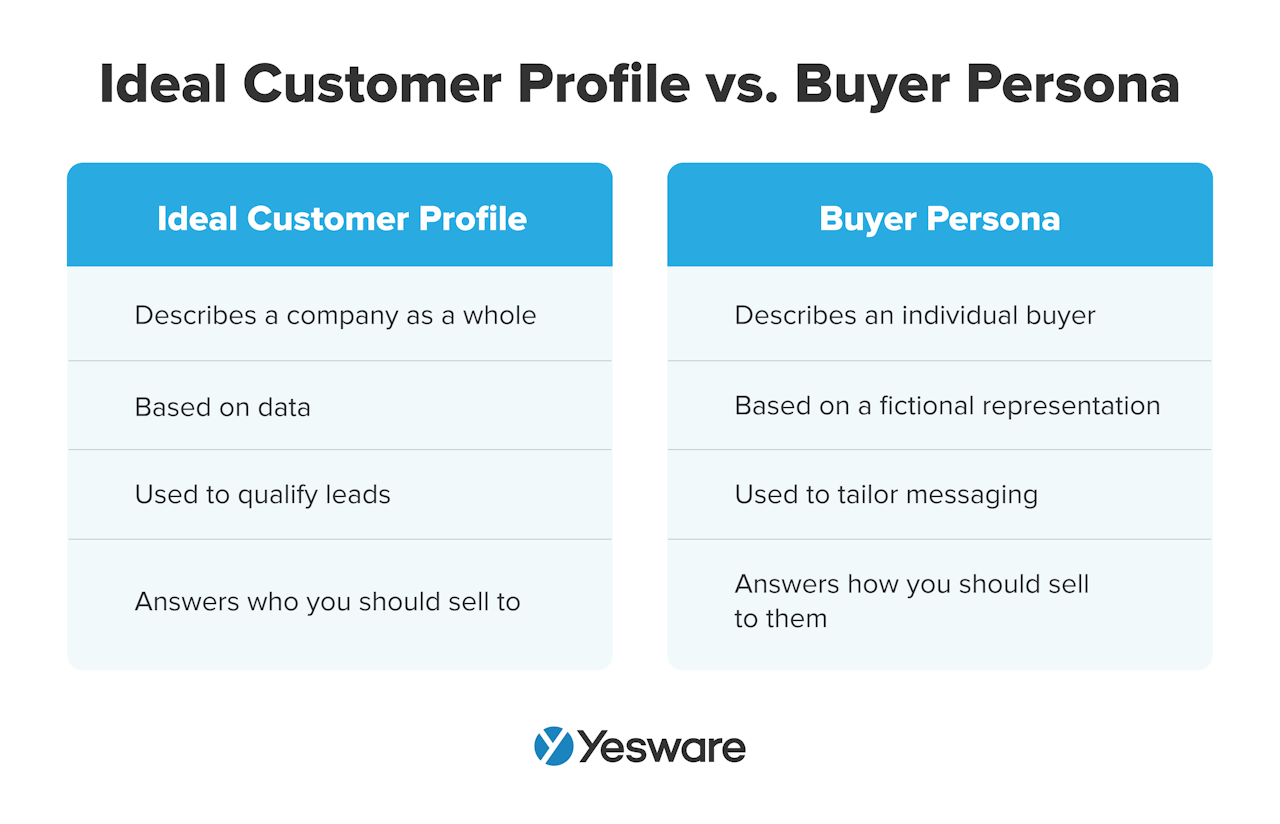 Another difference between the two is that, while the ICP is highly quantitative and data-based, the buyer persona leaves a bit more room for “fiction,” so to speak. The buyer persona is an imagined depiction (based on real data and anecdotes) of the personal traits, characteristics, motivations, challenges, goals, and quirks that make up a potential buyer.
Another difference between the two is that, while the ICP is highly quantitative and data-based, the buyer persona leaves a bit more room for “fiction,” so to speak. The buyer persona is an imagined depiction (based on real data and anecdotes) of the personal traits, characteristics, motivations, challenges, goals, and quirks that make up a potential buyer.
The difference is even more clear when you see an example of each back-to-back. Take a look: 
The Role of Buyer Personas
Though buyer personas are decidedly different from the ICP, they are no less important. The buyer persona includes details like: 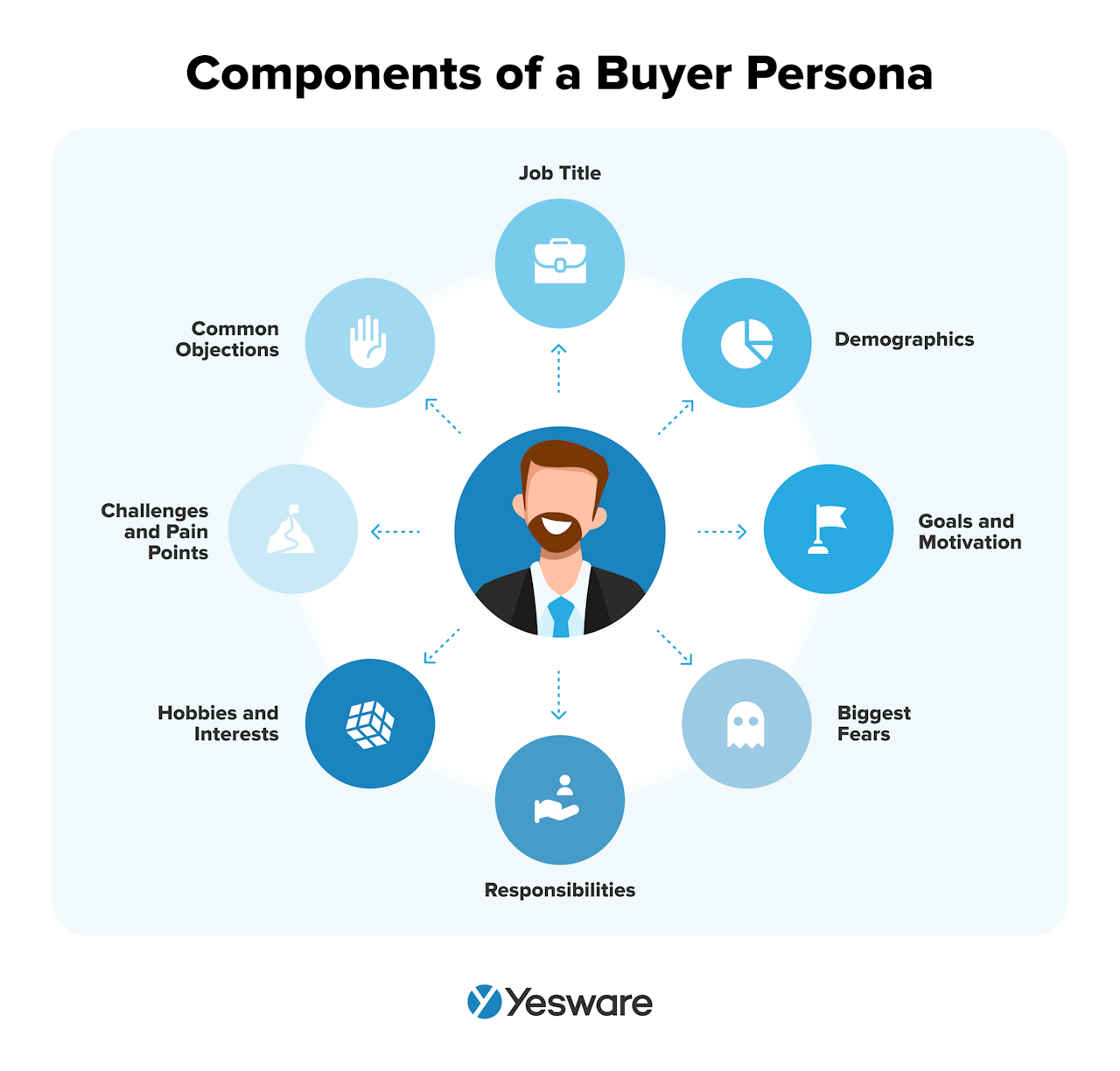 These are some of the most common components of a buyer persona.
These are some of the most common components of a buyer persona.
- Job title
- Demographics
- Goals and motivation
- Fears
- Responsibilities
- Hobbies and interests
- Challenges and pain points
- Common objections
Many buyer personas go much deeper than that, too, including information like marital status and salary. The more details that teams can include in their ICP and buyer personas, the more carefully they can craft a highly targeted sales message for each individual buyer.
Building a Sales ICP
The right way to build a sales ICP for your organization will depend on the strengths, resources, and buyer details of your sales and marketing teams.
Still, it’s important to define your collective vision ahead of time — what attributes and characteristics do you plan to include in the ICP?
Is employee count as important as YoY revenue, for example?
How do you plan to collect and verify the data you’re going to use to build the profile?
Who will be accountable for reviewing and revising the ICP?
The specifics of your data collection and collaborative process will vary, but it’s important nonetheless to answer these foundational questions before you begin the process.
Once you’ve clearly outlined the data you need to build your profile, it’s time to start collecting it.
Market Research and Data Analysis
If you want to know what happy, successful customers have in common, the best place to start is directly at the source.
Sales, marketing, and customer success teams should be ready to put time and effort into learning more about your organization’s highest-value customers. Look for accounts with high customer lifetime values (LTV) and average contract values (ACV).
Listen to how they speak about their challenges before finding your product, and what they were looking for in a solution. What were the selling points that tipped the scales for them? What were their expectations? Was there anything they were surprised by as they implemented your solution?
You may also want to ask more about topics that can’t necessarily be learned through research, like how widely their tech stack is adopted within their organization.
Be as generous with your time as customers are willing to be with theirs. Depending on their preferences (which would be included in their buyer persona!), you could approach this conversation via email survey, phone or in-person interview, focus groups, etc.
Though the ICP is meant to be a data-heavy document built primarily with real facts and figures (while the buyer persona is typically more verbally descriptive), it’s still important to solicit feedback from the real-world, best-fit buyers.
Part of your market research should also be competitive analysis. Who are the main competitors of your ICP? How can your offer give them leverage as they differentiate themselves from their competition?
Segmenting Your Customer Base
Anecdotal data can provide great support for an ICP, but the primary content that sales and marketing teams use to create the profile is firmographic, behavioral, and (sometimes) technographic data.
Most of this can be found within your team’s CRM platform, but you can also pull data from any sales intelligence or other reporting platform your team uses. Look for trends, patterns, and common themes among firmographic and behavioral data.
The five main types of firmographic data are industry, location, size, status/structure, and performance. 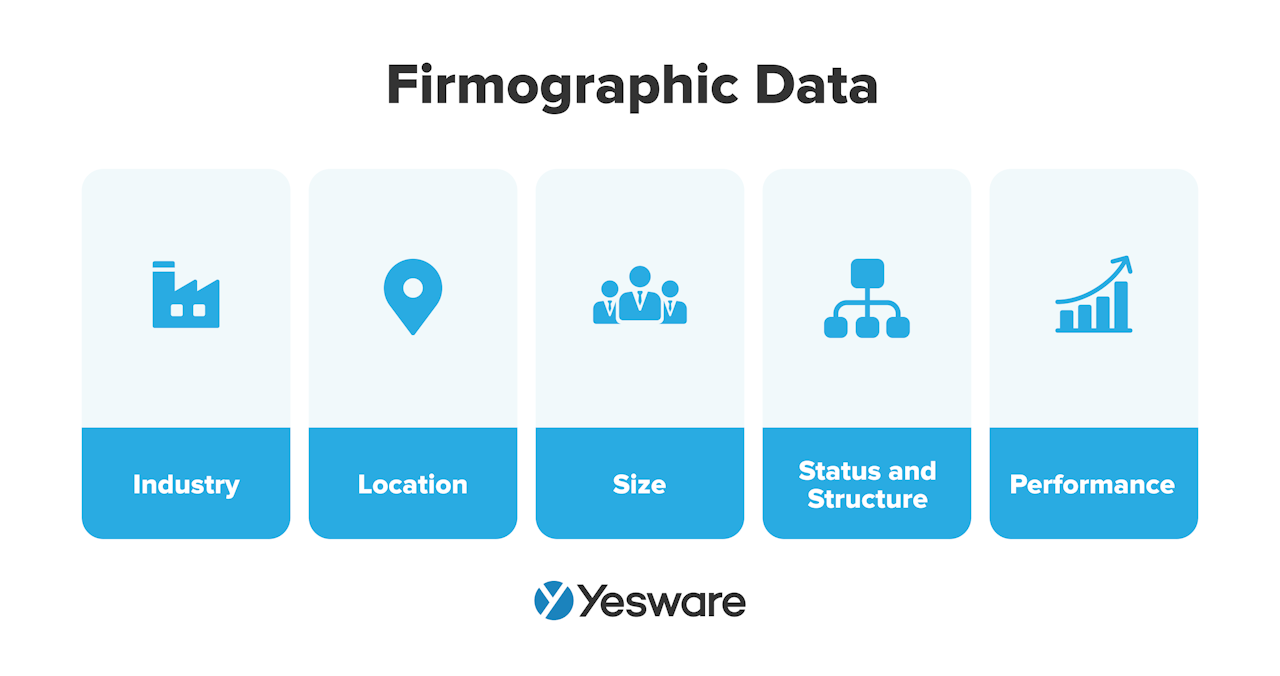 Behavioral data refers to information about an organization’s interactions with your business, or the way they behave as an organization in general. How many decision-makers are there? How long does it take to reach a decision?
Behavioral data refers to information about an organization’s interactions with your business, or the way they behave as an organization in general. How many decision-makers are there? How long does it take to reach a decision?  Technographic data refers to information about a company’s tech stack, including which platforms they use, how widely adopted they are, and how soon they’re due for renewal on each of their tech contracts.
Technographic data refers to information about a company’s tech stack, including which platforms they use, how widely adopted they are, and how soon they’re due for renewal on each of their tech contracts. 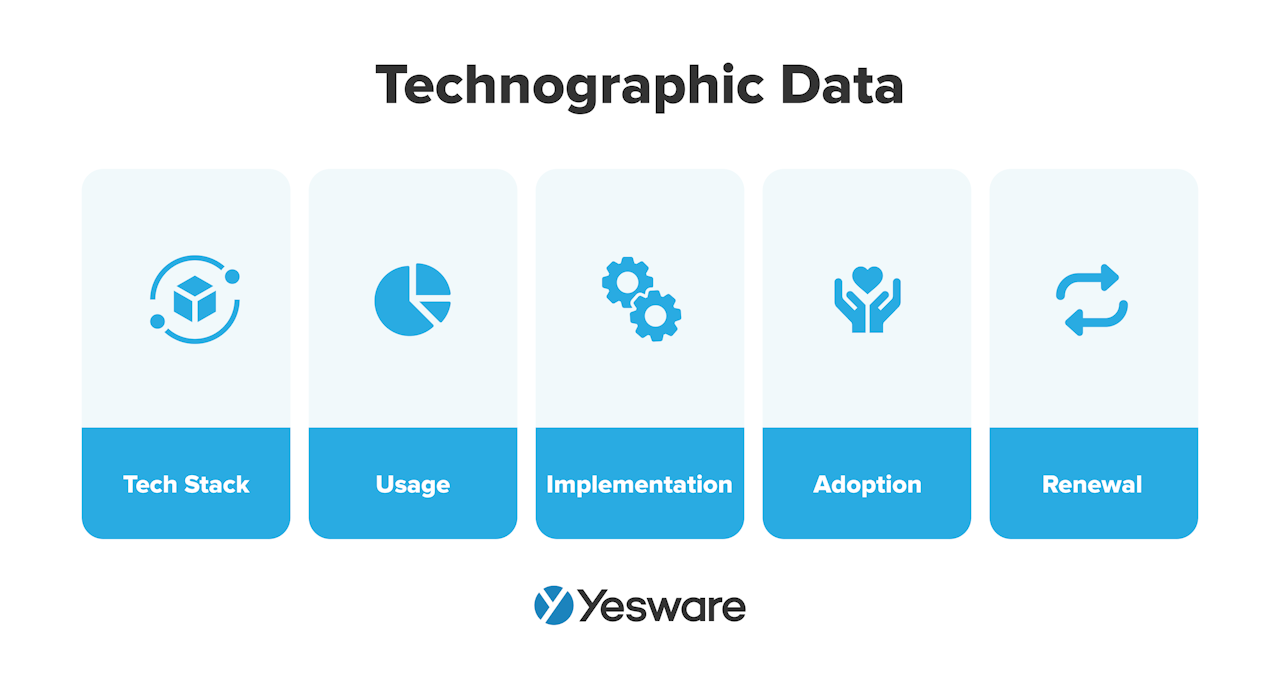
Refining Your ICP over Time
Even an outstanding ICP will eventually become obsolete over time. Part of the process of creating this document is making a plan (and sticking to it) for tracking and measuring its effectiveness, reviewing the results, and refining the profile as needed.
Though the ICP should be built on thorough data collection and analysis, complete with various sources and perspectives, the final document should be easy to read and concise. It’s designed to make prospecting faster and easier, so it needs to be high-level in order to help it serve its purpose.
Creating a Sales Playbook Aligned with Your ICP
Remember — the ICP is an action plan. Smart sales teams create the ICP to serve as a guiding force through the entire sales process.
As you create your sales playbook and strategize the various stages of the sales process, the ICP can help you target your messaging and approach. 
Developing Sales Strategies
The ideal customer profile can help sales teams determine the sales strategies that are most likely to resonate with best-fit buyers.
It can also outline buying signals commonly demonstrated by well-matched companies (i.e., a new round of funding, executive turnover, etc.) so that sales reps can set up automated alerts and implement their strategies at exactly the right time.
Sales Messaging and Value Proposition
The firmographic details in an ICP help sales and marketing teams develop perfectly curated messaging and value propositions. 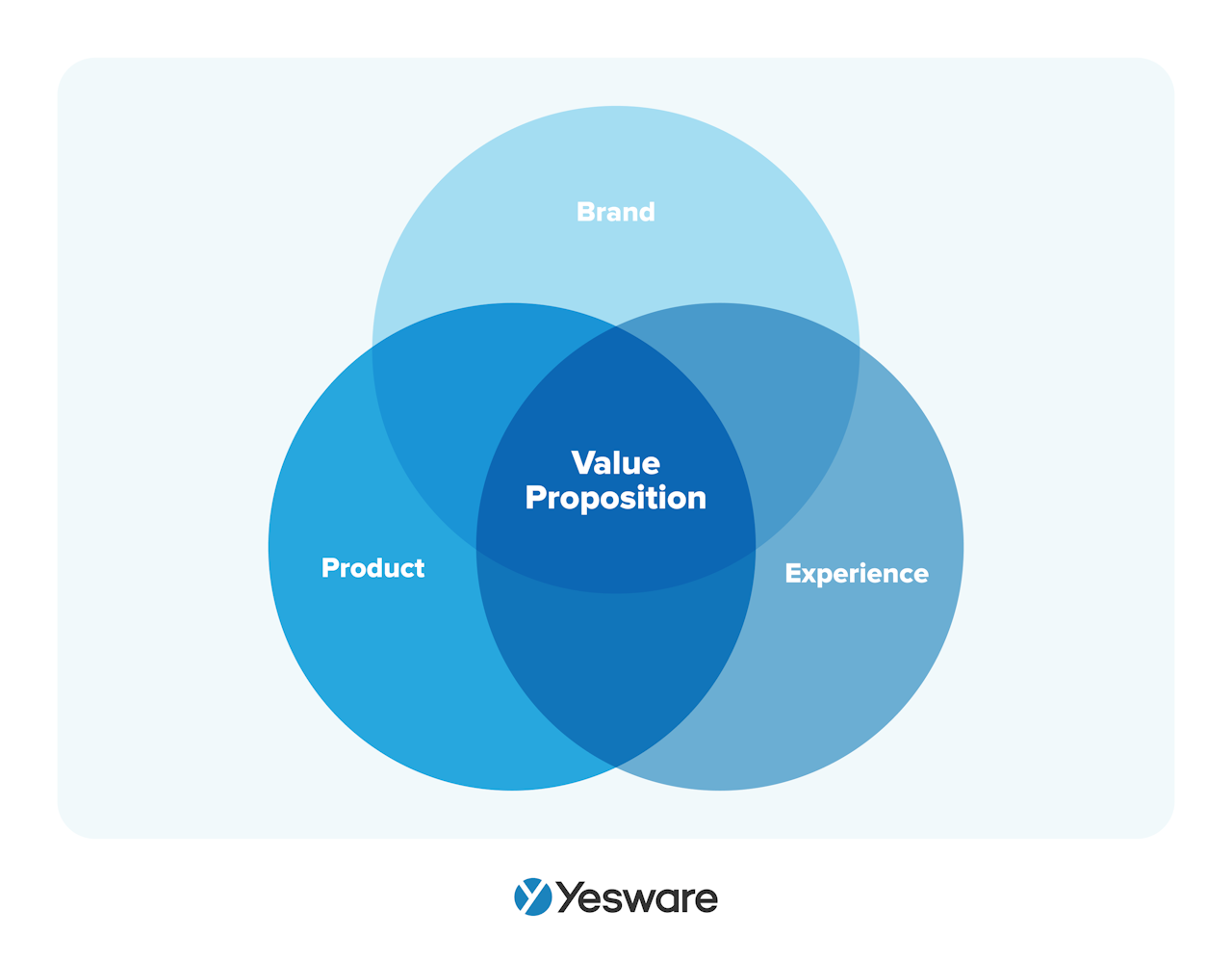 The meaning of the term “value” is in the eye of the beholder, so it’s essential that sales and marketing teams understand exactly what kind of value the best-fit customer is looking for in the sales process and within a solution.
The meaning of the term “value” is in the eye of the beholder, so it’s essential that sales and marketing teams understand exactly what kind of value the best-fit customer is looking for in the sales process and within a solution.
Sales Pitch Customization
If you’re wondering what to ask your successful customers for the sake of anecdotal data, you might see if there was anything in particular that stood out to them from your sales pitch. Chances are, their takeaways would likely resonate with similar-minded buyers — the more sales reps know what works, the more they can work it into future sales presentations.
Tip: view sales pitch examples here.
Sales Content Creation
To that end, all of the sales content/sales collateral that your team uses throughout the sales cycle should be tailored to speak to the needs of the ICP. The exact collateral your team uses will be highly specific and may include:
- Slide decks
- Customer testimonials/Case studies
- Demo materials
- Blog posts
- Landing pages
- Webinars
Use the ICP to reverse-engineer the creation of your sales content. The more personalized the content according to the details of the ICP, the more engaged the target audience will be.
And make sure that the content used is aligned with the buyer’s journey. 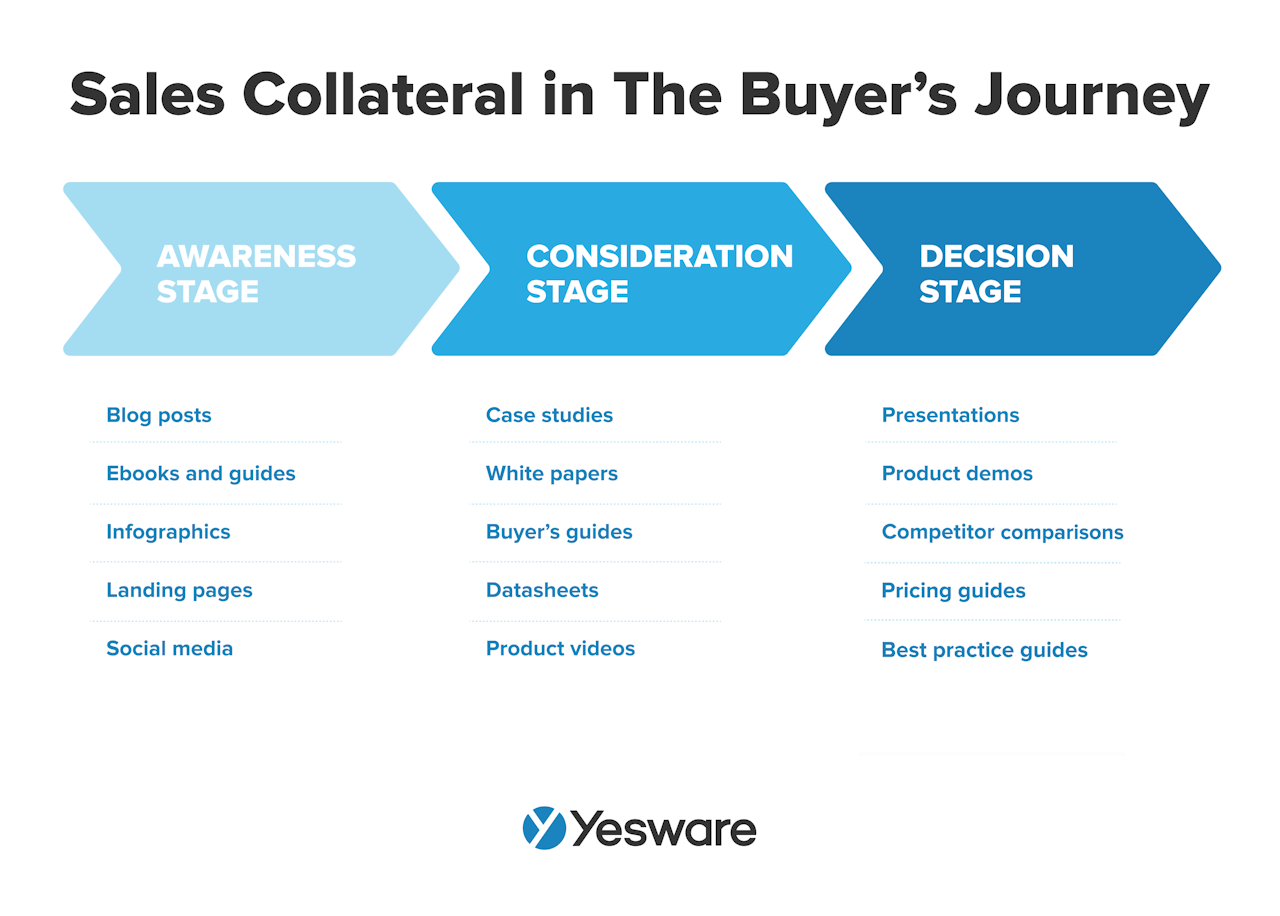
Lead Generation and Prospecting
To reiterate, the ICP is crucial for just about every stage of the sales process.
That being said, lead generation and sales prospecting are areas where the document is truly non-negotiable.
The ICP acts as a filter at the top of the sales funnel, where sales reps can compare leads coming in against the metrics of the profile. This makes fast, easy, and effective work of deciding which leads are worth a sales rep’s time, and which are potentially high-value enough that they should be prioritized ASAP.
Account-Based Marketing (ABM)
Speaking of high-value accounts, sales teams that master their ICP optimization can leverage the document for sophisticated account-based marketing (ABM) strategies.
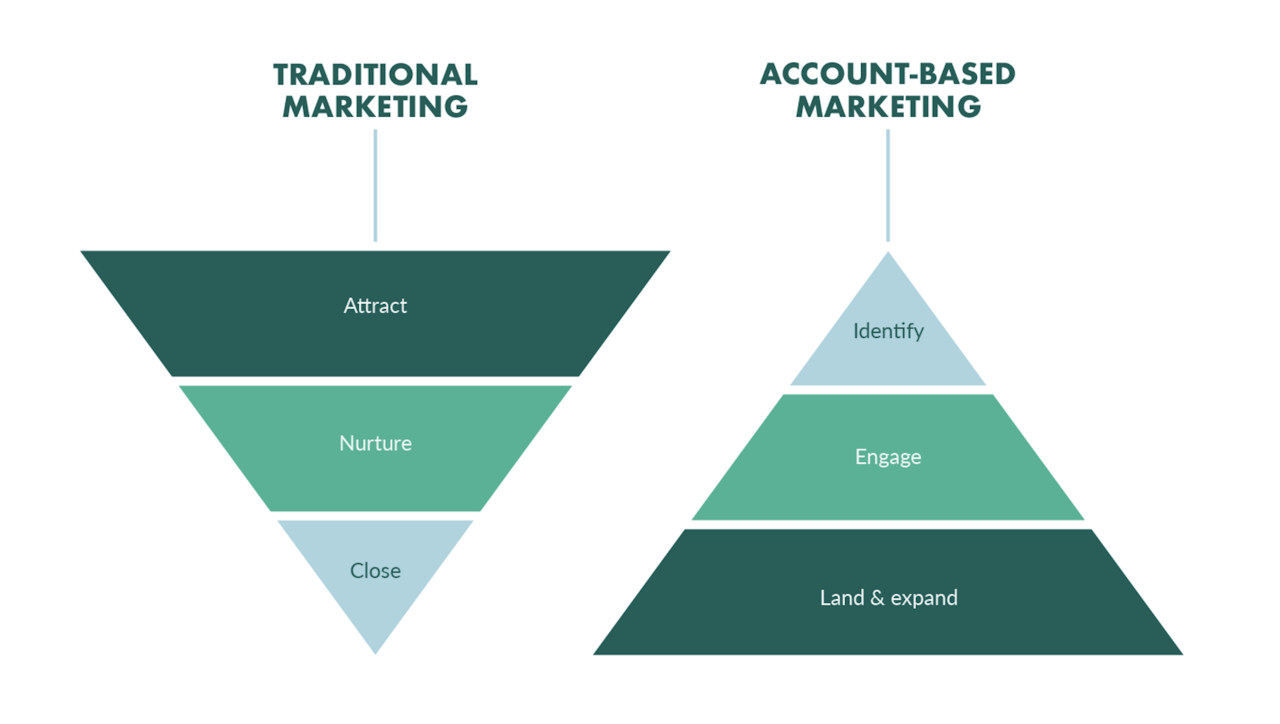
In essence, ABM is a highly-targeted marketing and sales strategy in which reps create hyper-personalized sales processes for key accounts selected based on how well they match the ICP criteria.
Sales Training and Onboarding
The ideal customer profile is also an important document for new hire onboarding and overall sales training. It helps sales reps understand exactly what they’re looking for in a highly qualified buyer, so they can quickly prioritize leads who are more likely to close. This, in turn, improves their quota attainment and the team’s overall conversion rate.
It also makes the training process more efficient. The more carefully you can drill down into common company pain points, goals, and needs during the sales process, the more efficiently you can train your team to navigate those filters in the field.
Tip: Grab more data-backed tips and strategies for your sales playbook:
 Sales Engagement Data Trends from 3+ Million Sales ActivitiesLooking at millions of tracked email activity over the past few years, this ebook is filled with our top studies and findings to help sales teams accelerate results.
Sales Engagement Data Trends from 3+ Million Sales ActivitiesLooking at millions of tracked email activity over the past few years, this ebook is filled with our top studies and findings to help sales teams accelerate results.
Identifying and Attracting Ideal Customers
Once you have your sales ICP and sales playbook outlined and aligned on paper, it’s time to put everything into action.
Sales and Marketing Alignment
If it hasn’t been clear already, sales and marketing need to be in complete lock-step as they create the ideal customer profile and implement it in real-world sales cycles.
Although attracting leads occurs at the top of the funnel, where marketing hands them off to sales, the benefits of proper sales and marketing alignment trickle all the way down to the bottom line.
Companies see an increase in revenue, brand awareness, and deal size.

Sales and marketing teams should also collaborate closely to clearly define the differences between a marketing qualified lead (MQL) and sales qualified lead (SQL) as they relate to the ICP. 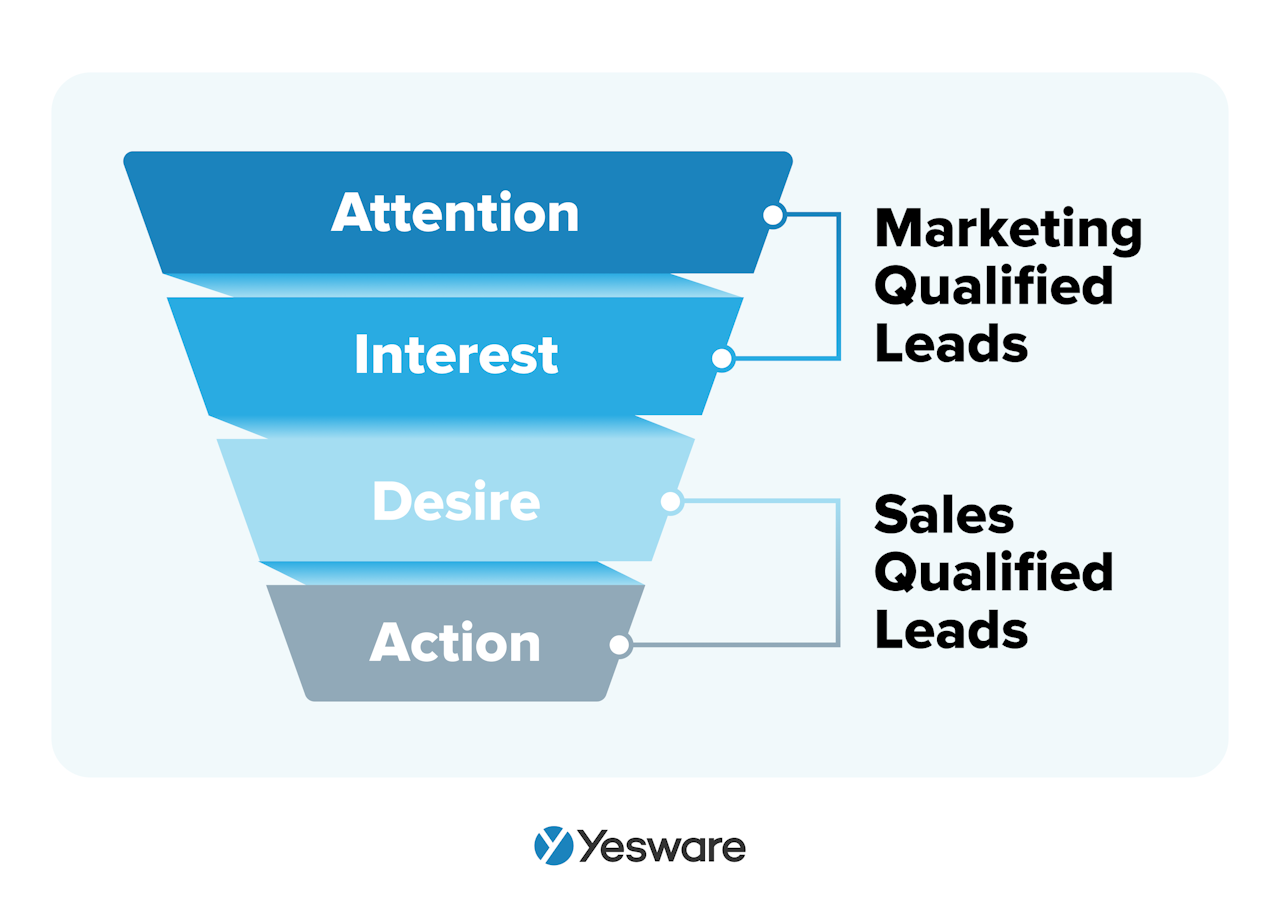
Lead Scoring and Qualification
Lead scoring and the ICP go hand-in-hand. The two can really benefit one another when used correctly.
Lead scoring is the process of assigning scores to leads for how closely they match the specific attributes outlined in the ICP.
If, for example, your ideal customer profile is located in the Northeast, a lead from New York City would score favorably. A lead from California would not.
Leads can also earn (or lose) points based on their behavior and engagement with your company. 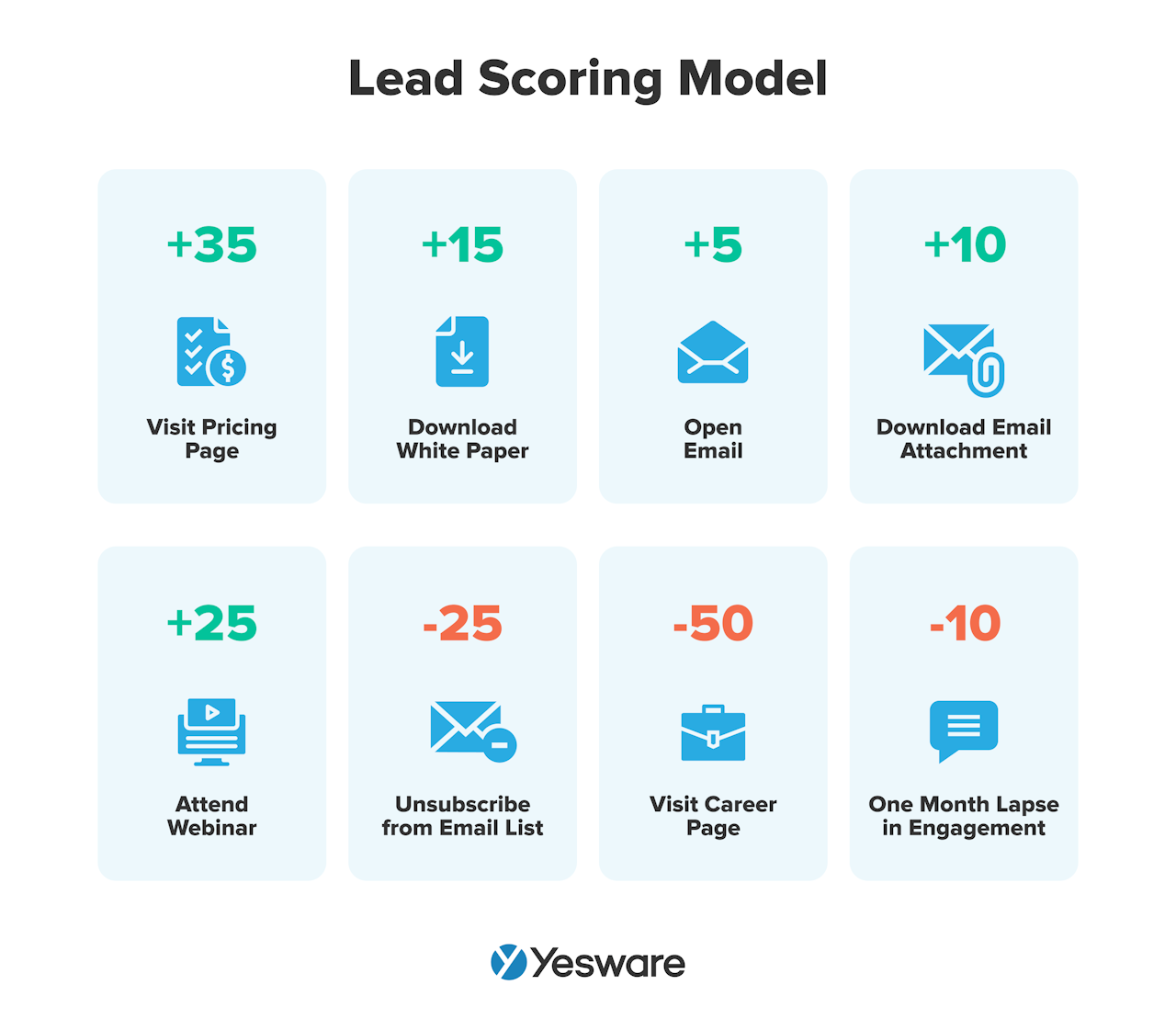 Lead scoring adds a lot of structure and standardization to the qualification process, much like the ICP does. The two concepts can work well together and can enhance each other’s benefits when executed correctly.
Lead scoring adds a lot of structure and standardization to the qualification process, much like the ICP does. The two concepts can work well together and can enhance each other’s benefits when executed correctly.
The Role of Marketing Automation
Fortunately, there are plenty of marketing automation tools available to sales and marketing teams that help keep best-fit leads nurtured as they navigate the top of the sales funnel. These platforms can help teams with everything from lead form creation to CRM integration to analytics and reporting.

Marketing automation can help teams collect massive amounts of data about company attributes and behavior, so the ICP can be corrected and strengthened over time.
Leveraging Technology and Tools
Even small businesses and those managing only a few leads at a time should take advantage of technology to attract high-quality, well-matched leads.
Email automation software like Yesware helps teams connect with prospects personally at scale, all while tracking their engagement and response to your approach.
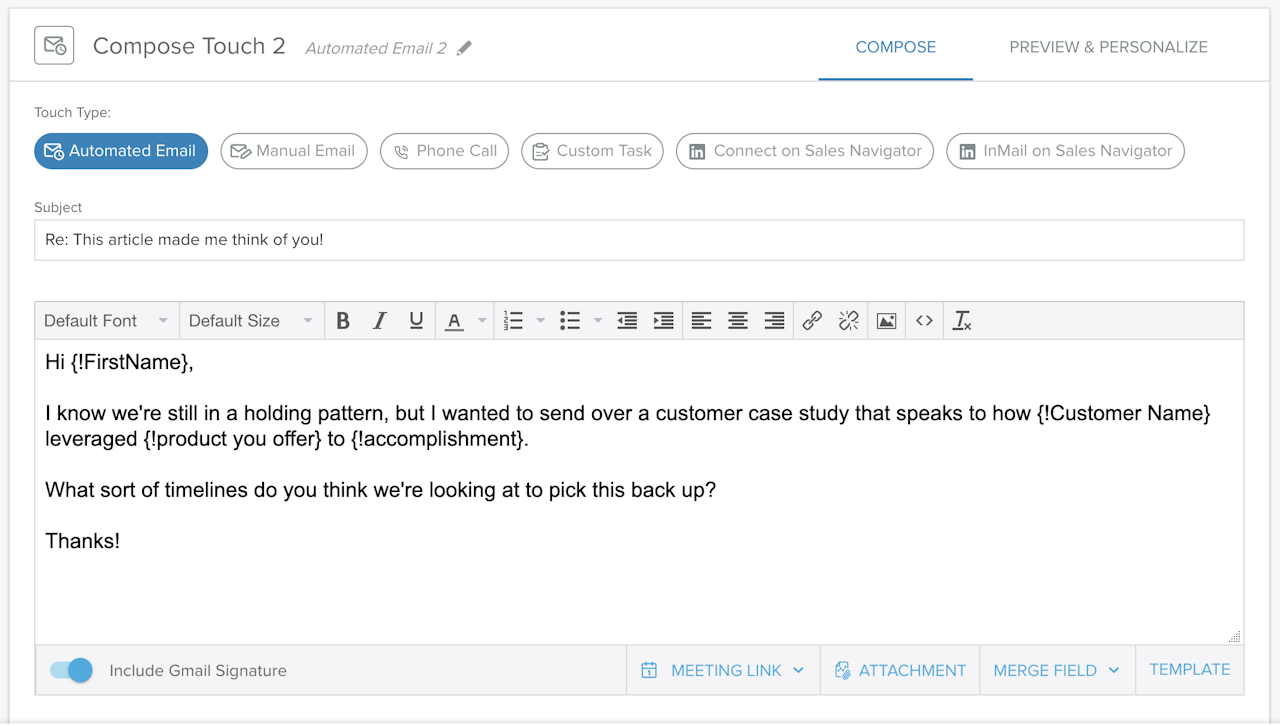
Our Prospector feature gives reps access to 100+ million B2B contacts, with advanced filters that allow them to sift through billions of data points with ease, leaving you with the highest potential leads.
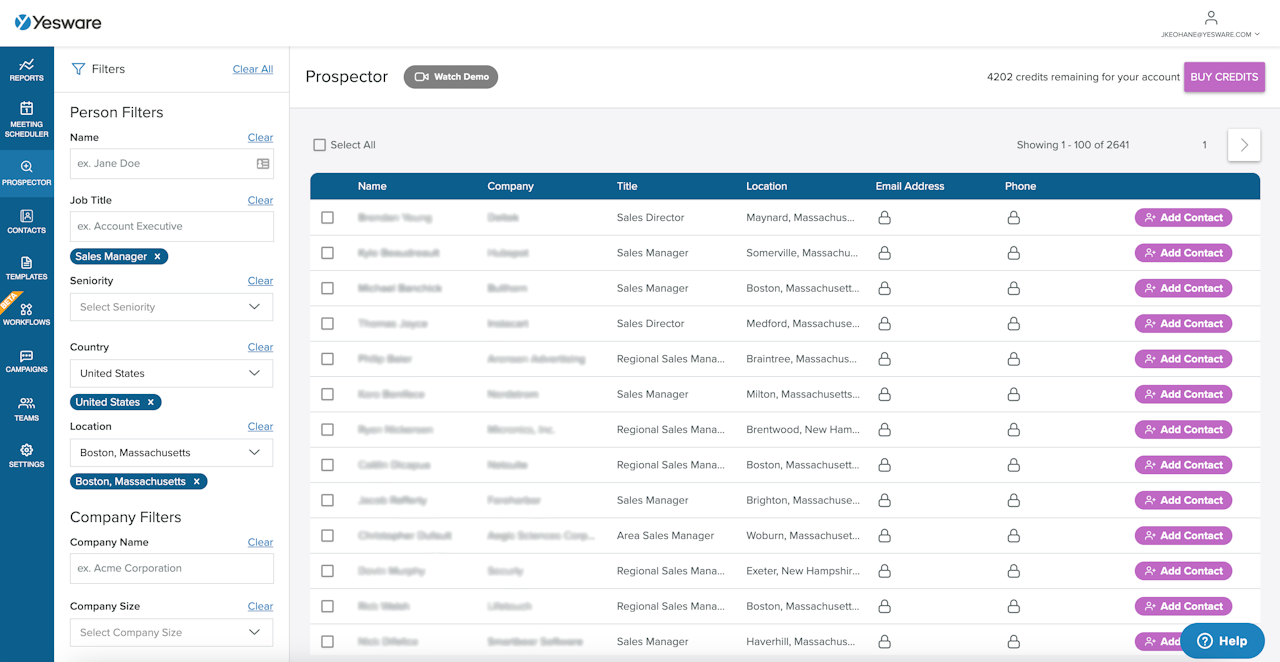
Measuring Sales ICP Effectiveness
Just like everything else in sales, it’s crucial that sales teams track and measure the effectiveness of their ICP efforts.
That being said, some sales and marketing teams struggle with this step, as it can seem somewhat abstract to measure how well a document “works” in the sales field.
One approach would be to A/B test the engagement and conversion rates of prospects who closely match the ICP, versus those who don’t.
If, for example, a prospect matches the ICP at a 90% rate, but is only 20% engaged throughout the sales cycle (however your team decides to determine those thresholds), that’s likely an indication that your ICP isn’t well-matched to what’s actually happening in the sales field.
Key Performance Indicators (KPIs)
There are also a few key performance indicators (KPIs) that marketing and sales teams can track that will shed light on how well your ICP is being leveraged throughout the sales process.
The conversion rate is an obvious one. If you’re converting at a solid rate, there’s a good chance your sales targeting is working well.
Customer acquisition cost (CAC) can also be a significant indicator. Customers who cost a lot of money to acquire can sometimes indicate a poor fit, suggesting that they were perhaps reluctant or unsure throughout the sales process.  It’s also a good idea to pay attention to sales cycle length. An efficient sales cycle can be a good sign that your marketing team is attracting the right people and that your sales team knows how to quickly connect with them on a personal and professional level once they’re engaged in the sales funnel.
It’s also a good idea to pay attention to sales cycle length. An efficient sales cycle can be a good sign that your marketing team is attracting the right people and that your sales team knows how to quickly connect with them on a personal and professional level once they’re engaged in the sales funnel. 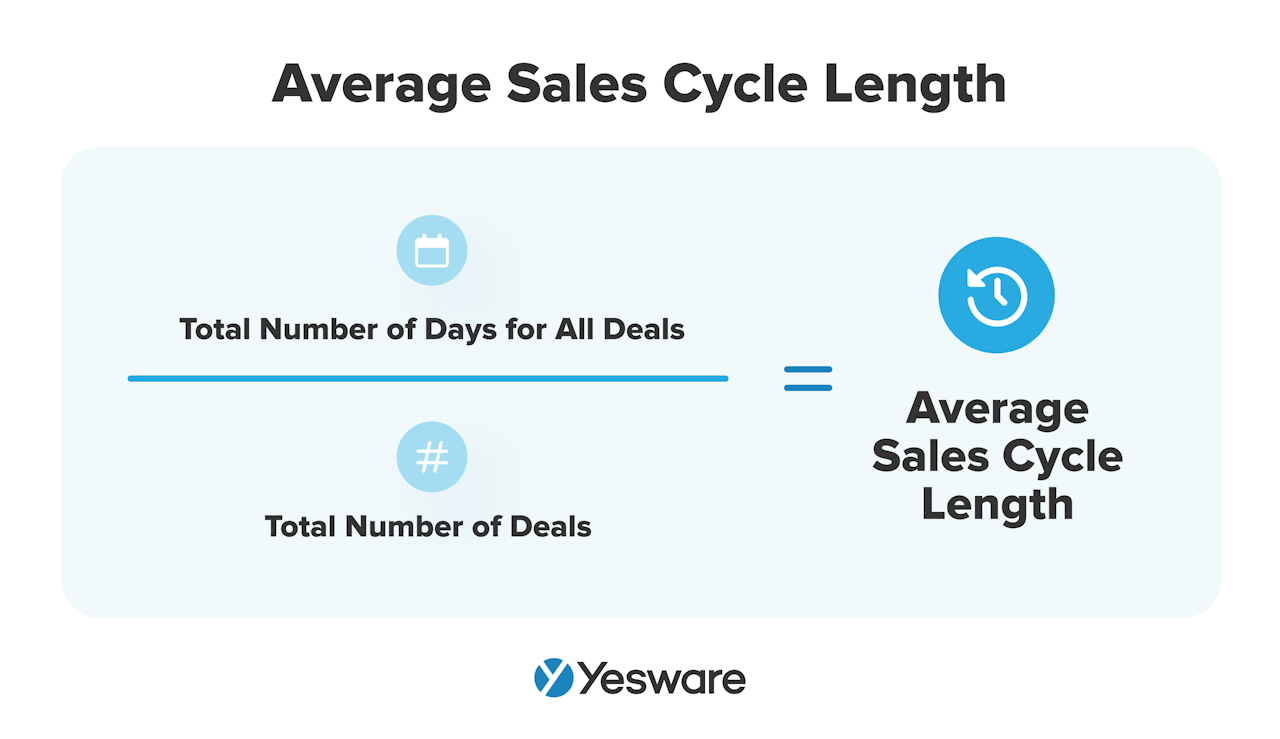 On the data collection side of things, customer lifetime value (LTV) and average contract value (ACV) can both represent good sources of data for great-fit companies.
On the data collection side of things, customer lifetime value (LTV) and average contract value (ACV) can both represent good sources of data for great-fit companies. 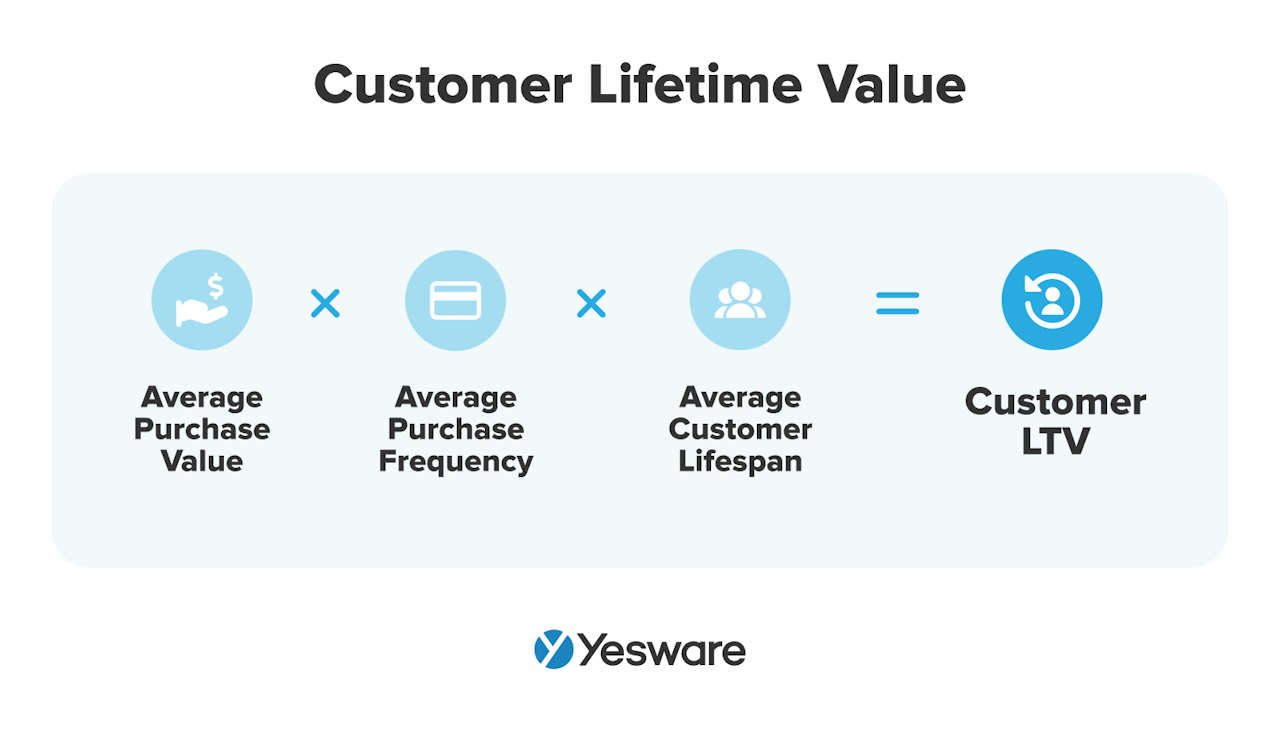 How did you create your sales ICP? When was the last time you evaluated and updated it? Is there an opportunity to create an additional ICP to help further personalize your sales efforts?
How did you create your sales ICP? When was the last time you evaluated and updated it? Is there an opportunity to create an additional ICP to help further personalize your sales efforts?
Get sales tips and strategies delivered straight to your inbox.
Yesware will help you generate more sales right from your inbox. Try our Outlook add-on or Gmail Chrome extension for free, forever!
Related Articles
Melissa Williams
Anya Vitko
Casey O'Connor
Sales, deal management, and communication tips for your inbox

